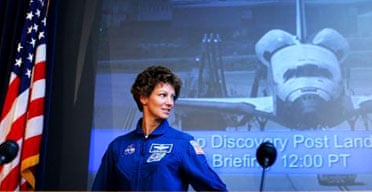Nasa managers spoke of their exhilaration and relief last night after the space shuttle's perfect return to Earth brought a successful end to America's first manned spaceflight since the Columbia disaster of two and half years ago.
There was one final twist to one of the most eventful shuttle missions in history, when a landing delayed four times by poor weather in Florida was switched to the pre-dawn darkness of a remote air force base in California's Mojave desert.
It meant that Commander Eileen Collins and her six fellow astronauts could not be reunited with their families until late last night.
But the lack of a showpiece touchdown at the Kennedy Space Centre, the shuttle fleet's home base, was a minor consideration on a day that finally allowed Nasa to restore pride to the space programme.
"Today we honoured the Columbia crew. We brought Discovery home safely," said Bill Parsons, the shuttle programme manager. "It's a great day. If you want to know how I feel, it's fantastic. It's good to be us today."
Cmdr Collins and the pilot, Jim Kelly, guided Discovery to a flawless landing after a 14-day mission that Nasa described as a test flight to assess more than $1bn of safety improvements made in the wake of the Columbia tragedy that killed seven astronauts.
Cmdr Collins admitted yesterday that she "thought of the Columbia crew every day of the mission", while Kelly said there were "moments of trepidation" as Discovery broke back into the Earth's atmosphere.
After a post-landing inspection, Cmdr Collins declared that the orbiter was "in great shape" despite the rigours of its 5.8 million-mile voyage - which included a docking with the international space station - and several technical glitches that required the first external repairs to a spacecraft in orbit.
A greater worry is the large chunk of foam that was seen breaking off the external fuel tank at lift-off on July 26, the same problem that doomed Columbia by striking a hole in its wing and allowing in deadly-hot gases during re-entry.
No damage was caused to Discovery, but Nasa has ordered its three remaining orbiters, Discovery, Atlantis and Endeavour, to remain on the ground until a solution is found.
The landing director, Leroy Cain, said low clouds and the threat of thunderstorms at Cape Canaveral had made it an easier decision to call off the landing there than on Monday, when the first two attempts were also scrubbed, allowing the astronauts an extra day in space.
He added the orbiter had behaved flawlessly during its hour-long descent from an altitude of 204 miles, in which it resisted temperatures of up to 1,650C.
Nasa will now have to spend up to $1m giving Discovery a piggyback ride back to Florida on a converted Boeing 747 jumbo jet to complete post-mission inspections and prepare it as a back-up to the next shuttle flight, whenever Atlantis is cleared for liftoff. Almost 250 workers will spend six days preparing Discovery for its journey home, which could take up to 10 days in short hops.
Discovery's crew, meanwhile, were dealing with the effects of gravity. Each had to drink several pints of salty fluids before re-entry.
"We're very happy to be back and we look forward to seeing everyone," Cmdr Collins said. "We had a fantastic mission."
